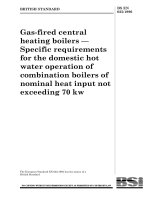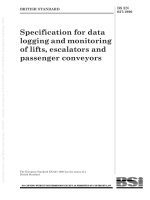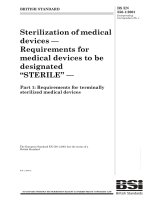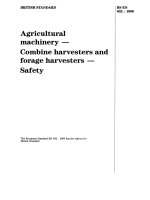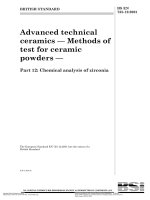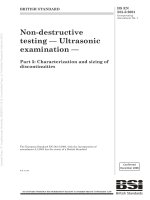Bsi bs en 61547 1996 (2001) iec 61547 1995
Bạn đang xem bản rút gọn của tài liệu. Xem và tải ngay bản đầy đủ của tài liệu tại đây (855.93 KB, 18 trang )
BRITISH STANDARD
BS EN
61547:1996
IEC
61547:1995
Incorporating
Amendment No. 1
Equipment for general
lighting purposes —
EMC immunity
requirements
The European Standard EN 61547:1995 with the incorporation of
amendment A1:2000 has the status of a British Standard
ICS 29.020; 29.140.00
BS EN 61547:1996
Committees responsible for this
British Standard
The preparation of this British Standard was entrusted to Technical
Committee CPL/34, Lamps and related equipment, upon which the following
bodies were represented:
British Sign Association
BSI Testing Product Certification
Consumer Policy Committee of BSI
Department of Trade and Industry (Consumer Safety Unit, CA Division)
Electrical Installation Equipment Manufacturers’ Association (BEAMA Ltd.)
Electricity Association
Institution of Civil Engineers
Institution of Lighting Engineers
Lighting Association
Lighting Industry Federation
Trinity House Lighthouse Service
Coopted members
This British Standard, having
been prepared under the
direction of the
Electrotechnical Sector Board,
was published under the
authority of the Standards
Board and comes into effect on
15 April 1996
© BSI 08-2001
The following BSI references
relate to the work on this
standard:
Committee reference CPL/34
Draft for comment
93/2126311 DC
ISBN 0 580 25262 0
Amendments issued since publication
Amd. No.
Date
Comments
13126
September 2001 See national foreword
BS EN 61547:1996
Contents
Committees responsible
National foreword
Foreword
Text of EN 61547
© BSI 08-2001
Page
Inside front cover
ii
2
5
i
BS EN 61547:1996
National foreword
This British Standard has been prepared by Technical Committee CPL/34 and is
the English language version of EN 61547:1995, Equipment for general purposes
EMC immunity requirements, including amendment A1:2000, published by the
European Committee for Electrotechnical Standardization (CENELEC). It is
identical with IEC 61547, including amendment 1:2000, published by the
International Electrotechnical Commission (IEC) which has the same title.
The start and finish of text introduced or altered by amendment is indicated in
the text by tags !". Tags indicating changes to IEC text carry the number of
the IEC amendment. For example, text altered by amendment 1 is indicated by.
From 1 January 1997, all IEC publications have the number 60000 added to the
old number. For instance, IEC 27-1 has been renumbered as IEC 60027-1. For a
period of time during the change over from one numbering system to the other,
publications may contain identifiers from both systems.!"
Cross-references
The British Standards which implement international or European publications
referred to in this document may be found in the BSI Standards Catalogue under
the section entitled International Standards Correspondence Index, or by using
the find facility of the BSI Standards Electronic Catalogue.
A British Standard does not purport to include all the necessary provisions of a
contract. Users of British Standards are responsible for their correct application.
Compliance with a British Standard does not of itself confer immunity
from legal obligations.
Summary of pages
This document comprises a front cover, an inside front cover, pages i and ii, the
EN title page, pages 2 to 12, an inside back cover and a back cover.
The BSI copyright notice displayed in this document indicates the most recent
changes by amendment.
ii
© BSI 08-2001
EUROPEAN STANDARD
EN 61547
NORME EUROPÉENNE
October 1995
+ A1
EUROPÄISCHE NORM
December 2000
ICS 29.020; 29.140.00
Descriptors: Lighting equipment, luminaire, lamp, connection, electric supply, low voltage, electromagnetic immunity, test,
performance, electrostatic discharge test, conformity assessment, test conditions
English version
Equipment for general lighting purposes EMC immunity
requirements
(includes amendment A1:2000)
(IEC 61547:1995 + A1:2000)
Equipements pour l’éclairage à usage général
Prescriptions concernant l’immunité CEM
(inclut l’amendement A1:2000)
(CEI 61547:1995 + A1:2000)
Einrichtung für allgemeine
Beleuchtungszwecke
EMV-Störfestigkeitsanforderungen
(enthält Änderungen A1:2000
(IEC 61547:1995 +A1:2000)
This European Standard was approved by CENELEC on 1995-09-20.
Amendment A1 was approved by CENELEC on 2000-11-01. CENELEC
members are bound to comply with the CEN/CENELEC Internal Regulations
which stipulate the conditions for giving this European Standard the status of a
national standard without any alteration.
Up-to-date lists and bibliographical references concerning such national
standards may be obtained on application to the Central Secretariat or to any
CENELEC member.
This European Standard exists in three official versions (English, French,
German). A version in any other language made by translation under the
responsibility of a CENELEC member into its own language and notified to the
Central Secretariat has the same status as the official versions.
CENELEC members are the national electrotechnical committees of Austria,
Belgium, Denmark, Finland, France, Germany, Greece, Iceland, Ireland, Italy,
Luxembourg, Netherlands, Norway, Portugal, Spain, Sweden, Switzerland and
United Kingdom.
CENELEC
European Committee for Electrotechnical Standardization
Comité Européen de Normalisation Electrotechnique
Europäisches Komitee für Elektrotechnische Normung
Central Secretariat: rue de Stassart 35, B-1050 Brussels
© 1995 Copyright reserved to CENELEC members
Ref. No. EN 61547:1995 + A1:2000 E
EN 61547:1995
Foreword
Foreword to amendment A1
The text of document 34/39/DIS, future edition 1 of
IEC 1547, prepared by IEC TC 34, Lamps and
related equipment, was submitted to the
IEC-CENELEC parallel vote and was approved by
CENELEC as EN 61547 on 1995-09-20.
The text of document 34/66/FDIS, future
amendment 1 to IEC 61547:1995, prepared by IEC
TC 34, Lamps and related equipment, was
submitted to the IEC-CENELEC parallel vote and
was approved by CENELEC as amendment A1 to
EN 61547:1995 on 2000-11-01.
The following dates were fixed:
— latest date by which the EN
has to be implemented at
national level by
publication of an identical
national standard or by
endorsement
(dop) 1996-07-01
— latest date by which the
national standards
conflicting with the EN
have to be withdrawn
(dow) 1996-07-01
Annexes designated “normative” are part of the
body of the standard. In this standard, Annex ZA is
normative. Annex ZA has been added by
CENELEC.
2
The following dates were fixed:
— latest date by which the
amendment has to be
implemented at national
level by publication of an
identical national standard
or by endorsement
(dop) 2001-08-01
— latest date by which the
national standards
conflicting with the
amendment have to be
withdrawn
(dow) 2003-11-01
© BSI 08-2001
EN 61547:1995
Contents
Foreword
1
Scope
2
Normative references
3
Definitions
4
Performance criteria
5
Test specifications
5.1 General
5.2 Electrostatic discharges
5.3 Radio frequency electromagnetic fields
5.4 Power frequency magnetic fields
5.5 Fast transients
5.6 Injected currents
5.7 Surges
5.8 Voltage dips and interruptions
5.9 Voltage fluctuations
6
Application of test specifications
6.1 General
6.2 Non-electronic lighting equipment
6.3 Electronic lighting equipment
7
Conditions during testing
8
Assessment of conformity
Annex ZA (normative) Normative references
to international publications with their
corresponding European publications
© BSI 08-2001
Page
2
5
5
6
6
7
7
7
8
8
8
9
9
10
10
10
10
10
10
11
11
12
Figure 1 — Examples of ports
Table 1 — Electrostatic discharges — Test
levels at enclosure port
Table 2 — Radio frequency electromagnetic
fields — Test levels at enclosure port
Table 3 — Power frequency magnetic fields —
Test levels at enclosure port
Table 4 — Fast transients — Test levels at
ports for signal and control lines
Table 5 — Fast transients — Test levels at
input and output d.c. power ports
Table 6 — Fast transients — Test levels at
input and output a.c. power ports
Table 7 — Injected currents — Test levels at
ports for signal and control lines
Table 8 — Injected currents — Test levels
at input and output d.c. power ports
Table 9 — Injected currents — Test levels
at input and output a.c. power ports
Table 10 — Surges — Test levels at input
a.c. power ports
Table 11 — Voltage dips and interruptions —
Test levels at input a.c. power ports
Table 12 — Voltage dips and interruptions —
Test levels at input a.c. power ports
Table 13 — Application of tests for
self-ballasted lamps
Table 14 — Application of tests for
independent auxiliaries
Table 15 — Application of tests for luminaires
Page
7
7
8
8
8
8
8
9
9
9
9
10
10
10
11
11
3
4
blank
EN 61547:1995
1 Scope
This International Standard for electromagnetic immunity requirements applies to lighting equipment
which is within the scope of IEC technical committee 34, such as lamps, auxiliaries and luminaires,
intended either for connecting to a low voltage electricity supply or for battery operation.
Excluded from the scope of this standard is equipment for which the immunity requirements are
formulated in other IEC or CISPR standards such as:
— lighting equipment for use in transport vehicles;
— entertainment lighting control equipment for professional purposes;
— lighting devices built-in other equipment such as:
• scale illumination or indicators;
• photocopiers;
• slide and overhead projectors;
• video display units.
However, in multi-function equipment where the lighting part operates independently from other parts,
the lighting part shall comply with the requirements of this standard.
The requirements of this standard are based on the requirements for domestic, commercial and
light-industrial environments as given in the future IEC 1000-6-11), but modified to lighting engineering
practice.
It can be expected that lighting equipment complying with the requirements of this standard will operate
satisfactorily in other environments. In some special cases measures have to be taken to provide greater
immunity. It is impracticable to deal with all these possibilities. Such requirements may be established by
contractual agreement between supplier and purchaser.
This standard shall be read in conjunction with the relevant basic and/or product standard(s).
2 Normative references
The following normative documents contain provisions which, through reference in this text, constitute
provisions of this International Standard. At the time of publication, the editions indicated were valid. All
normative documents are subject to revision, and parties to agreements based on this International
Standard are encouraged to investigate the possibility of applying the most recent editions to the normative
documents indicated below. Members of IEC and ISO maintain registers of currently valid International
Standards.
IEC 50(161):1990, International Electrotechnical Vocabulary — (IEV) Chapter 161: Electromagnetic
Compatibility.
IEC 50(845):1987, International Electrotechnical Vocabulary — (IEV) Chapter 845: Lighting.
IEC 598-1:1992, Luminaires — Part 1: General requirements and tests.
IEC 598-2-22:1990, Luminaires — Part 2: Particular requirements — Section 22: Luminaires for emergency
lighting.
IEC 1000-4-2:1995, Electromagnetic compatibility (EMC) — Part 4: Testing and measurement techniques
— Section 2: Electrostatic discharge immunity tests.
IEC 1000-4-3:1995, Electromagnetic compatibility (EMC) — Part 4: Testing and measurement
techniques — Section 3: Radiated, radio frequency, electromagnetic field immunity tests.
IEC 1000-4-4:1995, Electromagnetic compatibility (EMC) — Part 4: Testing and measurement
techniques — Section 4: Electrical fast transient/burst immunity tests.
IEC 1000-4-5:1995, Electromagnetic compatibility (EMC) — Part 4: Testing and measurement
techniques — Section 5: Surge immunity tests.
IEC/DIS 1000-4-6, Electromagnetic compatibility (EMC) — Part 4: Testing and measurement techniques —
Section 6: Immunity to conducted disturbances, induced by radio-frequency fields.
1)
At present at stage of document 77(sec)141
© BSI 08-2001
5
EN 61547:1995
IEC 1000-4-8:1993, Electromagnetic compatibility (EMC) — Part 4: Testing and measurement
techniques — Section 8: Power frequency magnetic field immunity tests.
IEC 1000-4-11:1994, Electromagnetic compatibility (EMC) — Part 4: Testing and measurement
techniques — Section 11: Voltage dips, short interruptions and voltage variations immunity tests.
3 Definitions
For the purpose of this International Standard, the definitions of IEC 50(161) and IEC 50(845) apply,
together with the following definitions:
3.1
port
particular electrical interface of the specified equipment with the external electromagnetic environment
3.2
enclosure port
the physical boundary of the equipment through which electromagnetic fields may radiate or penetrate
4 Performance criteria
4.1 A functional description of performance criteria, during or as a consequence of the immunity testing,
shall be provided by the manufacturer and noted in the test report.
The performance of lighting equipment shall be assessed by monitoring:
— the luminous intensity of the luminaire or of the lamp(s);
— the functioning of the control in case of equipment which includes a regulating control or concerns the
regulating control itself;
— the functioning of the starting device, if any.
4.2 The following performance criteria apply to lighting equipment:
Performance criterion A:
During the test no change of the luminous intensity shall be observed and the regulating control, if any,
shall operate during the test as intended.
Performance criterion B:
During the test the luminous intensity may change to any value. After the test the luminous intensity shall
be restored to its initial value within 1 min.
Regulating controls need not function during the test, but after the test the mode of the control shall be the
same as before the test provided that during the test no mode changing commands were given.
Performance criterion C:
During and after the test any change of the luminous intensity is allowed and the lamp(s) may be
extinguished. After the test, within 30 min, all functions shall return to normal if necessary by temporary
interruption of the mains supply and/or operating the regulating control.
Additional requirement for lighting equipment incorporating a starting device:
After the test the lighting equipment is switched off. After half an hour it is switched on again. The lighting
equipment shall start and operate as intended.
4.3 A change of luminous intensity may be checked by visual observation but in case of doubt the following
applies:
The luminous intensity of a luminaire or of the lamp(s) shall be measured by means of a illuminance (lux)
meter which is positioned in an axis perpendicular to the main plane of the luminaire or lamp(s), in its
centre and at a distance for proper operation of the lux meter. The luminous intensity shall be deemed to
be unchanged if the measured intensities do not deviate by more than 15 %.
Care shall be taken that the ambient light level does not influence the measuring result.
Precautions to achieve reproducible results given in the relevant lamp performance standards shall be
observed.
6
© BSI 08-2001
EN 61547:1995
NOTE
For the purpose of this standard, d.c. power ports for supplying regulating controls are considered to be signal ports.
Figure 1 — Examples of ports
4.4 Effects of electromagnetic phenomena as described in this standard on the life of the light sources, are
excluded from this standard.
5 Test specifications
5.1 General
Immunity requirements for equipment defined in the scope concern:
— electrostatic discharges;
— continuous and transient disturbances;
— radiated and conducted disturbances;
— radio frequency and mains supply related disturbances.
They are given in subclauses 5.2 to 5.9 on a port by port basis.
Tests are applied to the relevant ports of the equipment as indicated in the respective subclauses.
Tests shall be conducted in a well-defined and reproducible manner.
Tests shall be carried out as single tests in sequence. The sequence of testing is optional.
It may be determined from consideration of the electrical characteristics and usage of a particular
equipment that some of the tests are inappropriate and therefore unnecessary. In such cases it is required
that the decision not to test be recorded in the test report.
The description of the test, the test generator, the test methods and the test set-up are given in the basic
standards which are referred to in the relevant subclauses.
Test levels are generally based on level 2 values as recommended in the basic standards.
5.2 Electrostatic discharges
These tests are carried out according to IEC 1000-4-2, with test levels as given in Table 1 of this standard.
Contact discharge is the preferred test method. Twenty discharges (10 with positive and 10 with negative
polarity) shall be applied on each accessible metallic part of the enclosure, terminals are excluded. Air
discharges shall be used where contact discharges cannot be applied. Discharges shall be applied on the
horizontal or vertical coupling planes as specified in IEC 1000-4-2.
NOTE
“accessible” means accessible under normal operating conditions including user maintenance.
Table 1 — Electrostatic discharges — Test levels at enclosure port
Characteristics
Air discharge
Contact discharge
© BSI 08-2001
Test levels
8 kv
4 kv
7
EN 61547:1995
5.3 Radio frequency electromagnetic fields
These tests are carried out according to IEC 1000-4-3, with test levels as given in Table 2 of this standard.
Table 2 — Radio frequency electromagnetic fields — Test levels at enclosure port
Characteristics
Test levels
80 MHz to 1 000 MHz
3 V/m (unmodulated)
1 kHz, 80 % AM, sine wave
Frequency range
Test level
Modulation
5.4 Power frequency magnetic fields
These tests are carried out according to IEC 1000-4-8, with test levels as given in Table 3 of this standard
and need only to be applied to equipment containing components susceptible to magnetic fields, such as
Hall elements or magnetic field sensors.
In case of mains operated devices the test frequency shall be locked to the mains frequency.
Table 3 — Power frequency magnetic fields — Test levels at enclosure port
Characteristics
Field frequency
Test level
Test levels
50/60 Hz
3 A/m
5.5 Fast transients
These tests are carried out according to IEC 1000-4-4, with test levels as given in Table 4, Table 5
and Table 6 of this standard.
Fast transients are carried out during 2 min with a positive polarity and during 2 min with a negative
polarity.
Table 4 — Fast transients — Test levels at ports for signal and control lines
Characteristics
Test level
Rise time/hold time
Repetition frequency
Test levels
0,5 kV (peak)
5/50 ns
5 kHz
NOTE 1 Only applicable to ports interfacing with cables whose total length according to the manufacturer’s specification may
exceed 3 m.
NOTE 2
Change of state commands are not applied during the test.
Table 5 — Fast transients — Test levels at input and output d.c. power ports
Characteristics
Test level
Rise time/hold time
Repetition frequency
NOTE
Test levels
0,5 kV (peak)
5/50 ns
5 kHz
Not applicable to equipment not connected to the mains while in use.
Table 6 — Fast transients — Test levels at input and output a.c. power ports
Characteristics
Test level
Rise time/hold time
Repetition frequency
8
Test levels
1 kV (peak)
5/50 ns
5 kHz
© BSI 08-2001
EN 61547:1995
5.6 Injected currents
These tests are carried out according to IEC/DIS 1000-4-62), with test levels as given in Table 7, Table 8
and Table 9 of this standard. The preferred coupling and decoupling devices are:
AC mains:
Screened signal cables:
Unscreened signal cables:
CDN 801-M1/-M2/-M3
Direct injection (CDN 801-S)
Clamp injection.
Table 7 — Injected currents — Test levels at ports for signal and control lines
Characteristics
Test levels
0,15 MHz to 80 MHz
3 V r.m.s. (unmodulated)
1 kHz, 80 % AM, sine wave
150 7
Frequency range
Test level
Modulation
Source impedance
NOTE Only applicable to ports interfacing with cables whose total length according to the manufacturer’s specification may
exceed 1 m.
Table 8 — Injected currents — Test levels at input and output d.c. power ports
Characteristics
Test levels
Frequency range
Test level
Modulation
Source impedance
NOTE
0,15 MHz to 80 MHz
3 V r.m.s. (unmodulated)
1 kHz, 80 % AM, sine wave
150 7
Not applicable to equipment not connected to the mains while in use.
Table 9 — Injected currents — Test levels at input and output a.c. power ports
Characteristics
Test levels
Frequency range
Test level
Modulation
Source impedance
0,15 MHz to 80 MHz
3 V r.m.s. (unmodulated)
1 kHz, 80 % AM, sine wave
150 7
NOTE Only applicable to ports interfacing with cables whose total length according to the manufacturer’s specification may
exceed 1 m.
5.7 Surges
!These tests are carried out according to IEC 61000-4-5, with test levels as given in Table 10 of this
standard. Five positive and five negative pulses shall be applied at the peak value and zero crossing points
of the a.c. voltage wave. Two test levels are given for different types of lighting equipment.
Table 10 — Surges — Test levels at input a.c. power ports
Test levels
Device
Characteristics
Self-ballasted lamps and
semi-luminaires
Luminaires and independent
auxiliaries
Input power
u25 W
Wave-shape data
Test level
line to line
line to ground
1,2/50 4sss
0,5 kV
1,0 kV
1,2/50 4sss
0,5 kV
1,0 kV
>25 W
1,2/50 4sss
1,0 kV
2,0 kV
"
2)
At present at the stage of Draft International Standard.
© BSI 08-2001
9
EN 61547:1995
5.8 Voltage dips and interruptions
These tests are carried out according to IEC 1000-4-11, with test levels as given in Table 11 and Table 12
of this standard.
Table 11 — Voltage dips and interruptions — Test levels at input a.c. power ports
Characteristics
Test levels
Voltage reduction
Number of periods
30 %
10
Table 12 — Voltage dips and interruptions — Test levels at input a.c. power ports
Characteristics
Test levels
Voltage reduction
Number of periods
100 %
0,5
5.9 Voltage fluctuations
Tests regarding voltage fluctuations are part of equipment product standards.
6 Application of test specifications
6.1 General
The test requirements apply to the following lighting equipment:
— luminaires or equivalent appliances;
— independent auxiliaries;
— self-ballasted lamps.
Immunity requirements do not apply to lamps other than self-ballasted lamps, nor to auxiliaries
incorporated in luminaires, in self-ballasted lamps or in semi-luminaires. However, if separate tests have
proven that built-in auxiliaries such as ballasts or convertors comply with the requirements set for
independent auxiliaries, the luminaire is deemed to comply and need not be tested.
As a result of the application of the tests defined in this standard, the lighting equipment shall not become
dangerous or unsafe as defined in the relevant product standard.
6.2 Non-electronic lighting equipment
Lighting equipment, with the exception of emergency lighting luminaires, in which the light source is
mains frequency or battery operated and which does not contain any active electronic component is deemed
to fulfil the immunity requirements without testing.
6.3 Electronic lighting equipment
For lighting equipment containing active electronic components which e.g. convert or regulate the
operating voltage and/or the frequency of the light source, the requirements are given in
sub-clauses 6.3.1 to 6.3.3.
6.3.1 Self-ballasted lamps
Electronic self-ballasted lamps shall be tested in accordance with clause 5 and comply with the
performance criteria of Table 13.
6.3.2 Independent auxiliaries
Those auxiliaries which are independent as defined in their relevant product standard shall be tested in
accordance with clause 5 and comply with the performance criteria of Table 14.
6.3.3 Luminaires
Luminaires shall be tested in accordance with clause 5 and comply with the performance criteria of
Table 15.
Table 13 — Application of tests for self-ballasted lamps
Test (subclause)
5.2
Performance criterion B
10
5.3
5.4
5.5
5.6
5.7
A
A
B
A
C
5.8,
5.8,
Table 11 Table 12
C
B
© BSI 08-2001
XXXXX:YYYY
Table 14 — Application of tests for independent auxiliaries
Test (subclause) and performance criterion
Type of independent electronic
auxiliary
Ballast
Convertor
Starting device
Semi-luminaire
Regulating device for ballast
or convertor
a
5.2
5.3
B
B
B
B
B
5.4
A
A
A
A
A
A
A
A
A
A
5.5
5.6
B
B
B
B
B
A
A
A
A
A
5.8,
Table 11
5.7
C
C
C
C
B
C
C
C
C
C
5.8,
Table 12
Ba
B
B
B
B
Applies only to fluorescent lamp ballasts, for other discharge lamp ballasts performance criteria C applies.
Table 15 — Application of tests for luminaires
Type of luminaire
Test (subclause) and performance criterion
5.2
Luminaire with electronic convertor
Luminaire with electronic ballast for
fluorescent lamps
Luminaire with electronic ballast for
discharge lamps
Luminaire for emergency lighting
a
5.3
5.4
5.5
5.6
5.8,
Table 11
5.7
5.8,
Table 12
B
B
A
A
A
A
B
B
A
A
C
C
C
C
B
B
B
A
A
B
B
C
C
C
A
A
A
B
A
B
a
a
These tests do not apply as they are covered by the test in IEC 598-2-22.
7 Conditions during testing
The test shall be applied while the equipment is operated as intended under the normal operating
conditions laid down in the relevant product standard at stabilized luminous (radiant) flux and at normal
laboratory conditions.
For starting devices the operating conditions are under consideration.
Equipment including a regulating control shall be tested in three operating modes at about 20 %, 60 % and
100 % luminous intensity. The load shall be the maximum allowed.
Luminaires and independent auxiliaries shall be tested with lamps for which they are intended. In case
the equipment is suitable for lamps of different wattages, lamps of maximum wattage shall be applied.
Lamps shall be test lamps as described in Annex B of IEC 598-1.
For independent auxiliaries the length of the cables between device and lamp shall be 3 m unless the
manufacturer prescribes another length.
The configuration and mode of operation during the tests shall be precisely noted in the test report.
8 Assessment of conformity
Equipment manufactured in series shall be verified by performing type-testing on one representative
model or on one series-produced equipment.
The manufacturer or supplier shall ensure by means of his quality control system that the tested model or
equipment is representative for the series-produced equipment.
All equipment not produced in series shall be tested on an individual basis.
© BSI 08-2001
11
EN 61547:1995
Annex ZA (normative)
Normative references to international publications with their corresponding
European publications
This European Standard incorporates by dated or undated reference, provisions from other publications.
These normative references are cited at the appropriate places in the text and the publications are listed
hereafter. For dated references, subsequent amendments to or revisions of any of these publications apply
to this European Standard only when incorporated in it by amendment or revision. For undated references
the latest edition of the publication referred to applies (including amendments).
NOTE When the international publication has been modified by CENELEC common modifications, indicated by (mod), the relevant
EN/HD applies.
Publication
Year
Title
EN/HD
Year
IEC 50(161)
1990
—
—
IEC 50(845)
IEC 598-1
(mod)
IEC 598-2-22:1990
(mod)
IEC 1000-4-2
1987
1992
—
EN 60598-1
—
1993
IEC 1000-4-3
1995
IEC 1000-4-4
1995
International electrotechnical vocabulary (IEV)
Chapter 161: Electromagnetic compatibility
Chapter 845: Lighting
Luminaires
Part 1: General requirements and tests
Part 2: Particular requirements
Section 22: Luminaires for emergency lighting
Electromagnetic compatibility (EMC)
Part 4: Testing and measurement techniques —
Section 2: Electrostatic discharge immunity test
Section 3: Radiated, radio-frequency,
electromagnetic field immunity test
Section 4: Electrical fast transient/burst
immunity test
Section 5: Surge immunity test
Section 6: Immunity to conducted disturbances,
induced by radio-frequency fields
Section 8: Power frequency magnetic field
immunity test
Section 11: Voltage dips, short interruptions and
voltage variations immunity tests
1990
1995
IEC 1000-4-5
1995
IEC/DIS 1000-4-6 —
IEC 1000-4-8
1993
IEC 1000-4-11
1994
12
EN 60598-2-22 1990
EN 61000-4-2 1995
—
—
EN 61000-4-4 1995
EN 61000-4-5 1995
—
—
EN 61000-4-8 1993
EN 61000-4-11 1994
© BSI 08-2001
blank
BS EN
61547:1996
IEC
61547:1995
BSI — British Standards Institution
BSI is the independent national body responsible for preparing
British Standards. It presents the UK view on standards in Europe and at the
international level. It is incorporated by Royal Charter.
Revisions
British Standards are updated by amendment or revision. Users of
British Standards should make sure that they possess the latest amendments or
editions.
It is the constant aim of BSI to improve the quality of our products and services.
We would be grateful if anyone finding an inaccuracy or ambiguity while using
this British Standard would inform the Secretary of the technical committee
responsible, the identity of which can be found on the inside front cover.
Tel: 020 8996 9000. Fax: 020 8996 7400.
BSI offers members an individual updating service called PLUS which ensures
that subscribers automatically receive the latest editions of standards.
Buying standards
Orders for all BSI, international and foreign standards publications should be
addressed to Customer Services. Tel: 020 8996 9001. Fax: 020 8996 7001.
Standards are also available from the BSI website at .
In response to orders for international standards, it is BSI policy to supply the
BSI implementation of those that have been published as British Standards,
unless otherwise requested.
Information on standards
BSI provides a wide range of information on national, European and
international standards through its Library and its Technical Help to Exporters
Service. Various BSI electronic information services are also available which give
details on all its products and services. Contact the Information Centre.
Tel: 020 8996 7111. Fax: 020 8996 7048.
Subscribing members of BSI are kept up to date with standards developments
and receive substantial discounts on the purchase price of standards. For details
of these and other benefits contact Membership Administration.
Tel: 020 8996 7002. Fax: 020 8996 7001. Further information about BSI is
available on the BSI website at .
Copyright
Copyright subsists in all BSI publications. BSI also holds the copyright, in the
UK, of the publications of the international standardization bodies. Except as
permitted under the Copyright, Designs and Patents Act 1988 no extract may be
reproduced, stored in a retrieval system or transmitted in any form or by any
means – electronic, photocopying, recording or otherwise – without prior written
permission from BSI.
This does not preclude the free use, in the course of implementing the standard,
of necessary details such as symbols, and size, type or grade designations. If these
details are to be used for any other purpose than implementation then the prior
written permission of BSI must be obtained.
BSI
389 Chiswick High Road
London
W4 4AL
If permission is granted, the terms may include royalty payments or a licensing
agreement. Details and advice can be obtained from the Copyright Manager.
Tel: 020 8996 7070.
